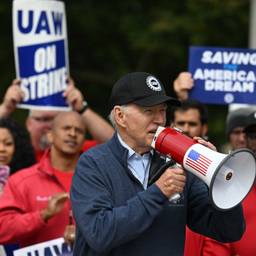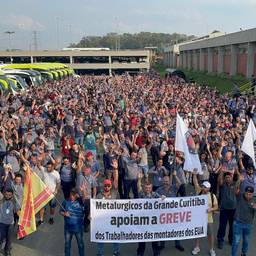UAW Autoworkers Strike Grows Larger, Stellantis Has Been Spared in This Round
The UAW strike that started Sept. 15 has now increased to 25,000 workers striking against the Big Three automakers. According to UAW President Shawn Fain, while negotiations continue with all of the Big Three, Stellantis has made “significant progress” on some issues.
Luis Feliz Leon
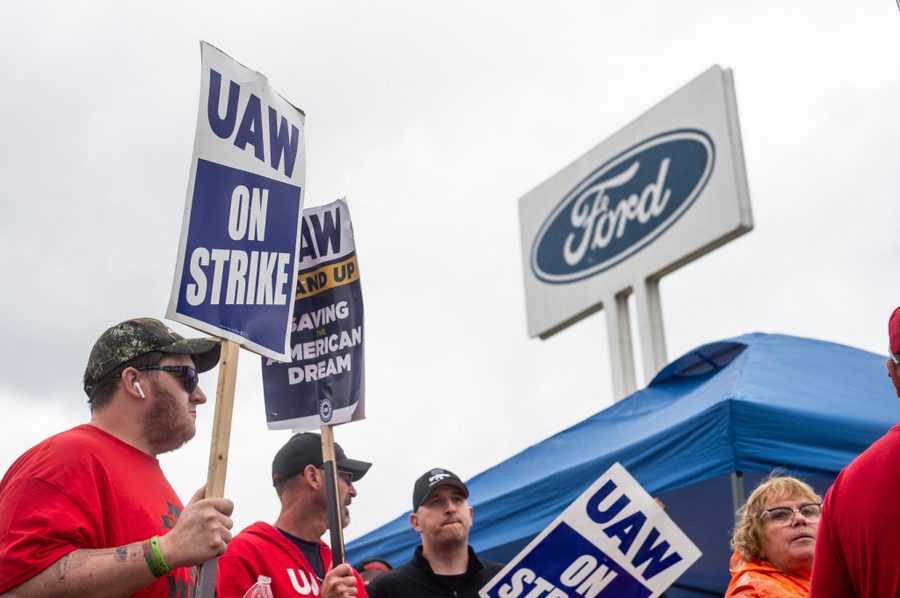
Seven thousand autoworkers at two more assembly plants will walk off the job at 12 p.m. ET today, UAW President Shawn Fain announced in a Facebook Live appearance Friday morning. Joining the strike are Ford’s Chicago Assembly plant and General Motors’ Lansing Delta Township Assembly in Michigan.
Fain announced that Stellantis would be spared this time. The union had been expected to strike all three companies, but, said Region 1 Director LaShawn English, three minutes before Fain was scheduled to go on Facebook Live, the UAW received frantic emails from company representatives.
According to Fain, Stellantis made “significant progress” on cost-of-living allowances, the right not to cross a picket line, and the right to strike over product commitments and plant closures. “We are excited about this momentum at Stellantis and hope it continues,” Fain said.
Fain made clear that negotiations with all three companies are ongoing. “I’m still very hopeful that we can reach a deal that reflects the incredible sacrifices and contributions our members have made over the last decade,” he said to 60,000 viewers on Facebook. “But I also know that what we win at the bargaining table depends on the power we build on the job. It’s time to use that power.”
Thursday afternoon, UAW Local 551 member Marcelina Pedraza said her co-workers at the Chicago Assembly plant were anxiously awaiting the news of the next targets.
“Everybody’s on edge,” said Pedraza, who is also a member of the reform caucus Unite All Workers for Democracy (UAWD). “It’s like the NFL draft picks. Are we going to be called next? Are we going to get a tentative agreement?”
She said workers were looking forward to Fain’s Facebook bargaining update, crediting the reform leadership with greater transparency and information sharing.
“My last two contracts were, ‘bargaining is going fine,’” she said, repeating what previous administrations said. “Then eventually, ‘here’s a shitty contract, we want you to vote yes on it.’”
When Pedraza clocked out Thursday, she and her skilled trades co-workers joked with the supervisor: “See you next week — maybe?”
Pedraza and her co-workers will make 25,000 auto workers now on picket lines as part of the union’s escalating Stand-Up strike, out of 146,000 UAW members at the Big Three.
“These guys wanted to go out a long time ago,” said Cody Zaremba, a Local 602 member at the Lansing GM plant after the news broke that his plant would be joining the strike. “We’re ready. Everybody, truly, I believe, in the entire membership. They’re one with what’s going on.”
Five thousand workers at 38 parts distribution centers across 21 states have been on strike since last Friday, along with 13,000 at three assembly plants in Michigan, Ohio and Missouri who walked out on September 15. (See a map of all struck facilities here.)
The UAW is now calling on community supporters to organize small teams to canvass dealerships that sell and repair Big Three cars and trucks. On Tuesday, the union issued a canvassing tool kit with instructions, flyers, press releases and talking points.
In negotiations with Ford and GM, auto workers have clinched some important gains. Among them is an agreement by both companies to end at least one of the many tiers in current contracts, putting workers at certain parts plants back on the same wage scale as assembly workers. The top rate for Big Three assembly workers is currently around $32.
Ford, GM and Stellantis have all proposed to shorten the time it takes workers to reach top pay from eight years to four. The UAW is still demanding workers receive top pay after 90 days.
Ford was spared in last week’s escalation, because bargainers there had made further progress on gains for workers.
But today the UAW once again called out workers at Ford and GM, putting some muscle behind its bold demands — a big wage boost, a shorter work week, elimination of tiers, cost-of-living adjustments tied to inflation, protection from plant closures, conversion of temps to permanent employees, and the restoration of retiree health care and benefit-defined pensions to all workers.
Previous UAW administrations had decoupled striking from winning — in 2019, 46,000 GM workers struck for 40 days but ended up with only paltry wage gains to show for it.
“Together we’re putting the fight back in the UAW and in the entire labor movement,” said Fain. “A union that’s not prepared to strike to win is like a fighter with one hand tied behind his back. Without the strike weapon, the war on workers is a rigged fight. For decades, it’s been the same story: unchecked corporate power, and disappearing worker power. The result is massive inequality across our society. To restore the balance of power we have to restore the strike.”
This year, for the first time in recent history, the union has played the three auto companies against each other with its strike strategy, departing from the union’s tradition of choosing one target company and patterning an agreement at the other two.
The Stand-Up Strike strategy draws inspiration from an approach known as CHAOS (Create Havoc Around Our System), first deployed in 1993 by Alaska Airlines flight attendants, who announced they would be striking random flights. Although they struck only seven flights in a two-month period, Alaska had to send scabs on every plane, just in case. The unpredictability drew enormous media attention and drove management up the wall. Meanwhile the union was able to conserve its strength and minimize risk.
The companies miscalculated where the UAW was going to strike first, stockpiling engines and shipping them cross-country to the wrong facilities. Autoworkers relished the self-inflicted supply chain chaos on UAW Facebook groups and other social media platforms.
Non-strikers’ morale on the factory floor has gotten a boost from rank and filers organizing to refuse voluntary overtime. With support both from Fain and the reform caucus UAWD, workers have been encouraging each other to “Eight and Skate,” meaning to turn down extra work and decline to do management any favors.
“We’re hawking every little change they’re making, like job assignments or parts moves,” said Luigi Gjokaj, Local 51 vice president at the Stellantis Mack plant. “Anything out of the ordinary, we’re pushing back. We’re paying attention to discipline; are they giving a written warning or time off when they would have done a verbal warning before? Our stewards are on high alert. Our committee people are being very diligent.
“Management has been real quiet this week. They’re a little gun-shy now.”
A majority of Americans support the UAW strikers, and the Big Three have taken a P.R. hit since the strike began, according to a new survey conducted by the business intelligence firm Caliber.
“Eighty-seven percent of respondents told us they were aware of the strike,” Caliber CEO Shahar Silbershatz told The Intercept. “It’s clear the strike is not just causing commercial repercussions, but reputational repercussions as well.”
These reputational repercussions will only worsen. Five strikers were hit by a vehicle leaving a GM parts center in Swartz Creek, Michigan, on the afternoon of September 26. Strikers in Massachusetts and California have also reported incidents of violence against them on picket lines.
GM deployed scabs at its parts depots this week — the only company that has done so, as far as we know. Stellantis has lined up scabs to swoop in and keep parts flowing, but it’s not clear whether they’ve actually started working at struck locations.
When Labor Notes reached out for comment the day before scabs were reporting to work, GM said that it was dispatching salaried employees to perform their normal duties. The company didn’t say it had put a job listing on recruitment websites paying $14 an hour for scabs to do the work of striking autoworkers.
One GM non-union employee told Labor Notes that the company is circulating a questionnaire among salaried employees to prepare to deploy them as scabs at parts distribution centers. Questions reportedly include, “Can you work out-of-town for two weeks/three weeks/duration of the work stoppage?,” “Are you trained and certified in Mobile Equipment?,” and “Are you comfortable working at heights up to 30 feet?” At least some salaried workers are counseling each other on how to turn down the request.
On Tuesday, President Joe Biden walked the picket line with autoworkers — the first time a sitting U.S. president has walked a picket line. While to Labor Notes readers that might sound like a low bar — last December, Biden and Congress intervened to block a national railroad strike — Biden’s latest decision surely must have rankled the corporate elite.
Former President Donald Trump was also in Michigan this week, speaking at a non-union auto parts plant. “Coming to Michigan to speak at a non-union employer and pretending it has anything to do with our fight at the Big Three is just more verbal diarrhea from the former president,” said UAW Vice President Mike Booth.
Those with government power can make or break unions. During the UAW’s Flint sit-down strike in 1936-37, Michigan Gov. Frank Murphy declined to use the National Guard to crush the 44-day sit-in — which went on to force GM to recognize the UAW. By contrast, Ronald Regan’s decision to fire air traffic contractors in 1981 had a chilling effect—dubbed the “PATCO Syndrome” — on workers organizing strikes throughout the 1980s and 1990s.
Labor historian Nelson Lichtenstein credits the ever-expanding strike with pressuring Biden in the run-up to the 2024 election, challenging the common canard that social disruptions would hurt the re-election prospects of Democrats. “Lyndon B. Johnson told Martin Luther King, Jr. in the months before the 1964 election ‘don’t have any more demonstrations. That’s going to be bad in getting me re-elected,’’’ Lichtenstein said. “But LBJ was wrong.”
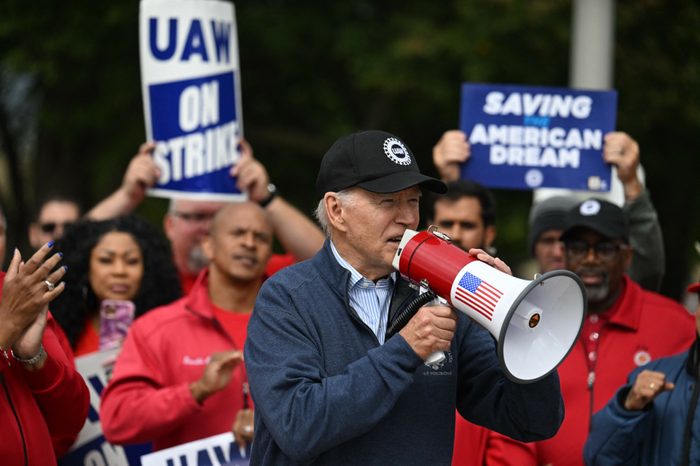
“Today, you need a demonstration of worker power and solidarity,” Lichtenstein said. “If Biden knows what’s good for him, he’ll continue to support the auto workers as he did when he visited their picket line. This strike has become a social movement with the capacity to mobilize enormous numbers of working class people on behalf of the trade unions and those politicians who demonstrate their solidarity with the UAW and other unions.”
Workers are seeing employers make money hand over fist while they work harder for wages that are worth less and less. That not only drives the shift in expectations that we are seeing but creates the chance for pitched battles — like the one at the Big Three — to become national referendums on capitalism.
Fain didn’t pull any punches in his speech after Biden, drawing a historical parallel between the autoworkers who built B-24 Liberator bombers during World War II and those on strike today.
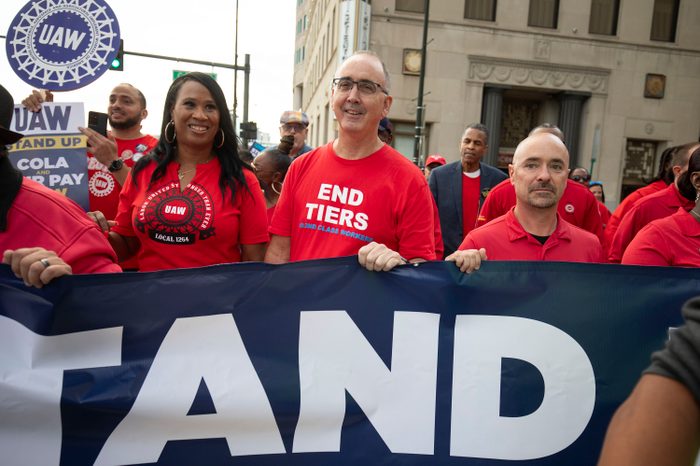
Eighty years later, “it’s a different kind of war we’re fighting,” Fain said. “Today, the enemy isn’t some foreign country miles away. It’s right here in our own area. It’s corporate greed.
“And the weapon we produce to fight that enemy is the liberators — the true liberators. It’s the working-class people.
“And the difference between them and us is, just as our theme song ‘Solidarity Forever’ says: ‘Without our brain and muscle, not a single wheel would turn.’
“That’s what’s different about working-class people. Whether we’re building cars or trucks or running parts distribution centers; whether we’re writing movies or performing TV shows; whether we’re making coffee at Starbucks; whether it’s nursing people back to health; whether it’s educating students, from preschool to college — we do the heavy lifting. We do the real work. Not the CEOs, not the executives.
“And though we don’t know it, that’s what power is. We have the power. The world is of our making. The economy is of our making. This industry is of our making.
“And as we’ve shown, when we withhold our labor, we can unmake it.”
This story originally appeared in Labor Notes and is being reprinted with permission.
Luis Feliz Leon is an associate editor and organizer at Labor Notes.

